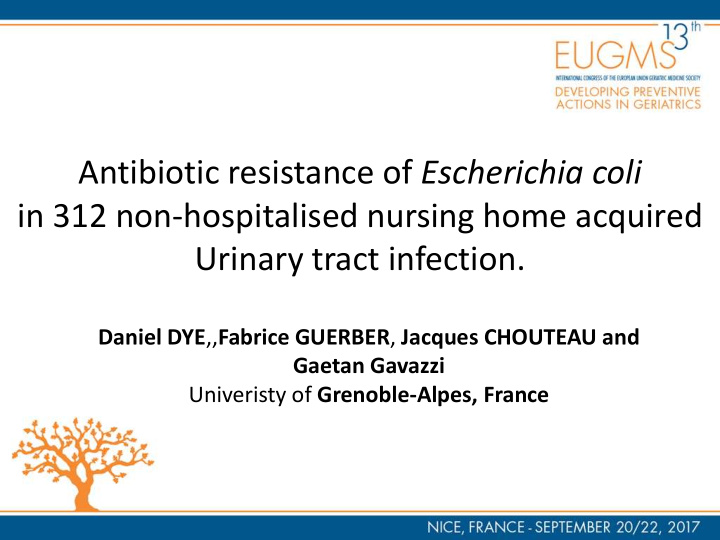



Antibiotic resistance of Escherichia coli in 312 non-hospitalised nursing home acquired Urinary tract infection. Daniel DYE ,, Fabrice GUERBER , Jacques CHOUTEAU and Gaetan Gavazzi Univeristy of Grenoble-Alpes, France
CONFLICT OF INTEREST DISCLOSURE I have no potential conflict of interest to report For this presentation
Background Urinary tract infection = major infection in Nursing home Antibiotic-therapy in Nursing Home vary from 2-10%. UTI is the number reason for empirical use, Prophylactic use of ATB Inappropriate empirical therapy in a high-risk population 40-60% Leads to the risk of emerging resistance / Highly variable Gavazzi G Lancet Inf Dis 2002, Mody L JAGS, Latour K Pharmacol Drug Saf 2012,
Background E coli is the main bacteria responsible for UTI and bacteraemia and takes part of Intestinal flora in older population. Hypothesis The surveillance of E coli antibiotic susceptibility is of clinical importance and may represent an overview of ATBic susceptibility in NH. Aim of the study Analyse ATBic resistance of Escherichia coli in urine culture collected in 12 NH of the same French area. Latour K Pharmacol Drug Saf 2012, Chami K, J Hosp Infect. 2011
Methods Retrospective study From 03 2014 to 09 2015 Bacteriological analysis from urine sample Community private laboratory All positive performed in 12 NH because of UTI suspicion. All urine cultures positives for E. coli All usual antibiotics were tested. (penicillin/ cephalosporin/ Aminosides, furan / fosfomycin) for C3G resistance , Cephalosporinasis and ESBL differenciation
Results Uricult Positive Uricult Positive E. coli E. coli with number (%) for Rate % ESBL E. coli 167 95 (56.9%) 29 30.5% 3 (11%) 160 79 (49.4%) 31 39.3% - 57 38 (66.6%) 12 31.6% - 193 112 (58%) 34 30.4% 2 (5.5%) 187 108 57.8% 30 28.6% 1 (3.3%) 137 87 (63.5%) 37 42.5% 1 (2 ,7) 129 78 (60.5%) 31 39.7% 1 (3,2) 102 74 (72.5%) 30 40.5% - 59 30 (50.8%) 7 23.3% - 35 19 (54.9%) 9 47.4% - 178 138 (77.5%) 45 32.6% 4 (9.5%) 59 46 (77.9%) 17 36.9% - 1463 904 (61.8%) 312 34.5% 12 (3.8%) � 2014 to 09 2015
Antibiotic resistances N= 312 Amoxicillin 52%, Amoxicillin+ clavulanate 34% Ceftriaxone 11,8% Cefexime 14,1% Ciprofloxacine 17.9% Imipenems, 0 % Gentmamycine, 2.2 Furane 1,9 Fosfomycine 2,5 Global ESBL E coli : 3.8 % However 2 Nursing homes with ESBL E coli rate 10%
Discussion / Conclusion Regarding the high level of resistance Amoxcicllin, coamoxiclav can no longer be used as empirical treatment; Of concern, resistance to 3 rd cephalosporin generation, becoming higher than one at the university Hospital of the area. ESBL was already very high in some NH This suggests that NH may act as a reservoir of multidrug resistance bacteria and A risk of cross transmission Yet, Surveillance of the resistance is critical in NH to better guide the empirical therapy. The most simple and frequent Is Urinculture
Thank you for your Attention ……. too less …. …..or too much “The good physician treats the disease; the great physician treats the patient who has the disease.” William Osler
Recommend
More recommend